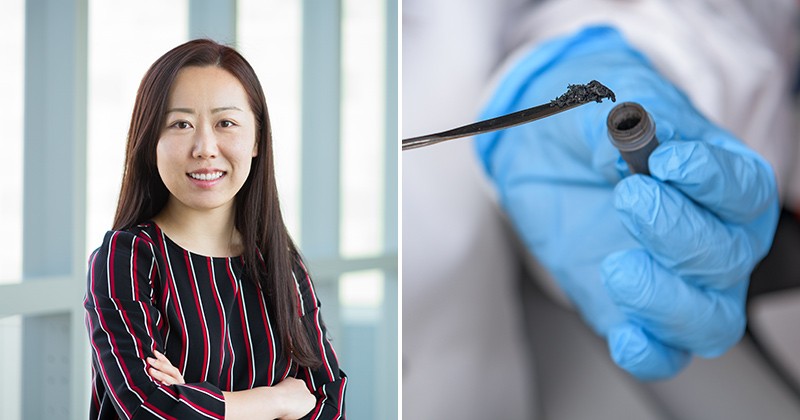UD grad student Danhui Xin wins awards for solving mysteries around pollution-reducing technology
In about 500 B.C., indigenous people in the Amazon began using pyrogenic carbon to increase soil fertility in nutrient-poor jungle soils.
Pyrogenic carbon is the material produced by burning biomass — trees, plants and animal waste — with limited oxygen. Pyrogenic carbon is produced globally at a rate of more than 100 million tons per year through wildfires, deforestation, volcanic lava and fossil fuel combustion.
Driven by the search for answers to climate change and environmental pollution, pyrogenic carbon has recently become a hot research topic.
Pyrogenic carbon is now being applied to various environmental problems, including removing nitrogen and disease-causing microbes from water. Pyrogenic carbon may increase crop production by improving soil fertility. It may also be critical in storing carbon to fight climate change.
Danhui Xin, a doctoral candidate in the University of Delaware’s Department of Civil and Environmental Engineering, studied its use to remove chemicals found in explosives from water.
Knowing more about how pyrogenic carbon works may help us fight climate change and other pollution problems.
Xin’s research is helping scientists understand the how behind the effectiveness of pyrogenic carbon as an environmental decontaminant. Her innovative research has earned three national student research awards so far.
To optimize pyrogenic carbon’s use in these various applications, scientists need a greater understanding of the electron storage capacity (ESC) of pyrogenic carbon. ESC is what makes pyrogenic carbon valuable in addressing environmental issues.
That’s where Xin’s research comes in.
“We were trying to understand the origin of electron storage capacity,” she said. “Where is this property coming from?”
ESC is the capacity of pyrogenic carbon to store and exchange electrons with chemical and biological components in the environment. ESC can lead to the transformation of pollutants into environmentally nontoxic compounds.
Xin’s research showed that pyrolysis — processing biomass at high temperature without enough air — creates the ESC of pyrogenic carbon.
Xin developed a chemical method — currently the only method — to correctly quantify the ESC of pyrogenic carbon. She identified the origin of ESC and imaged where it occurs on and within carbon. She also demonstrated its reversibility and long-lasting nature, and determined what controls the rate of electron exchange.
Her testing showed that three different components of wood can be used to make pyrogenic carbon and create ESC. So use of pyrogenic carbon to clean up pollutants has the added benefit of being a beneficial reuse of a waste product. Xin also showed that using a different starting material can influence the ESC and how efficient the pyrogenic carbon is for different kinds of pollution removal. This could lead scientists to customize pyrogenic carbon to transform certain pollutants.
“Danhui’s research has contributed tremendously to our understanding of the electron storage capacity of pyrogenic carbon,” said Pei Chiu, professor of civil and environmental engineering and Xin’s faculty adviser. “Her work has provided knowledge and tools and sparked important questions for the research community. Because ESC was discovered only seven years ago and its implications and applications are still being understood and discovered, I expect Danhui’s work to have continued impacts in the future.”
Xin’s groundbreaking work earned her the following awards:
- A 2020 Graduate Student Award in Environmental Chemistry from the Division of Environmental Chemistry (ENVR) of the American Chemical Society (ACS). Xin’s faculty adviser nominated her for this award.
- The C. Ellen Gonter Environmental Chemistry Paper Award. This is the highest award given to students by ENVR-ACS. Her paper is now published in ACS Sustainable Chemistry & Engineering journal.
- The Exchange Travel Award given by ENVR and the Society of Environmental Toxicology and Chemistry, North America (SETAC). This award supports Xin’s travel to present at the 2021 SETAC conference.
“I am honored and thrilled to win these awards,” said Xin, “because I can share my latest research with a broader audience, especially at the more industry-focused SETAC event. I hope they can use what I learned in their work to better understand how and why pyrogenic carbon works.”
Xin is also a DENIN Environmental Fellow and a recipient of a University dissertation fellowship from the Graduate College.
Xin will finish her doctorate this year and is currently seeking a university postdoctoral research position. After that she hopes to find a research and teaching job at a U.S. university.
Article by Joy Drohan, Eco-Write, LLC | Photos by Evan Krape | June 29, 2021

